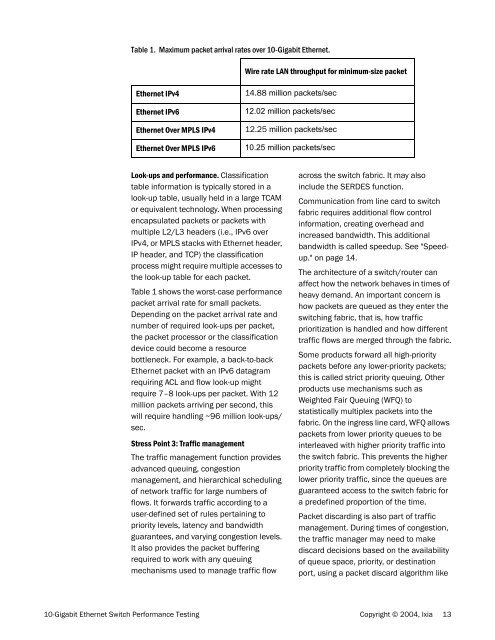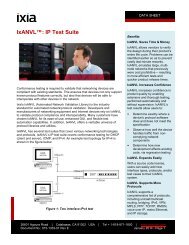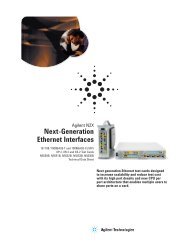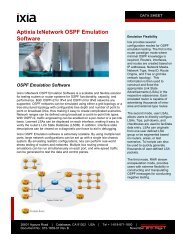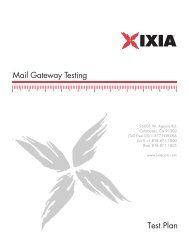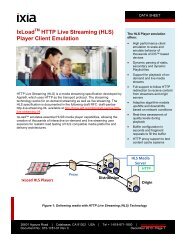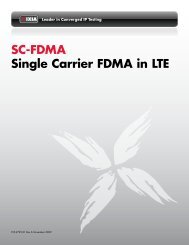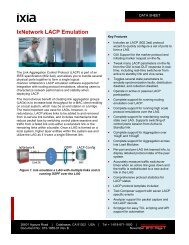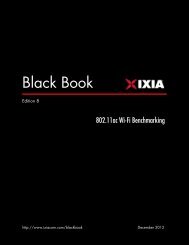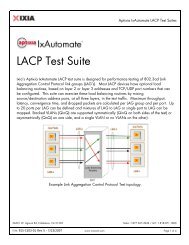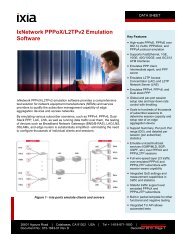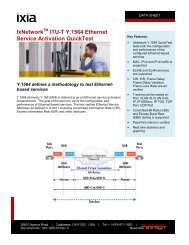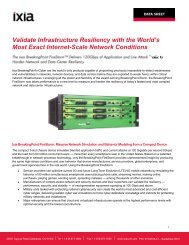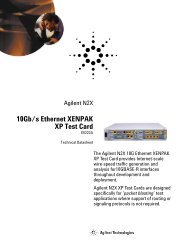10-Gigabit Ethernet Switch Performance Testing - Ixia
10-Gigabit Ethernet Switch Performance Testing - Ixia
10-Gigabit Ethernet Switch Performance Testing - Ixia
Create successful ePaper yourself
Turn your PDF publications into a flip-book with our unique Google optimized e-Paper software.
Table 1. Maximum packet arrival rates over <strong>10</strong>-<strong>Gigabit</strong> <strong>Ethernet</strong>.<br />
Look-ups and performance. Classification<br />
table information is typically stored in a<br />
look-up table, usually held in a large TCAM<br />
or equivalent technology. When processing<br />
encapsulated packets or packets with<br />
multiple L2/L3 headers (i.e., IPv6 over<br />
IPv4, or MPLS stacks with <strong>Ethernet</strong> header,<br />
IP header, and TCP) the classification<br />
process might require multiple accesses to<br />
the look-up table for each packet.<br />
Table 1 shows the worst-case performance<br />
packet arrival rate for small packets.<br />
Depending on the packet arrival rate and<br />
number of required look-ups per packet,<br />
the packet processor or the classification<br />
device could become a resource<br />
bottleneck. For example, a back-to-back<br />
<strong>Ethernet</strong> packet with an IPv6 datagram<br />
requiring ACL and flow look-up might<br />
require 7–8 look-ups per packet. With 12<br />
million packets arriving per second, this<br />
will require handling ~96 million look-ups/<br />
sec.<br />
Stress Point 3: Traffic management<br />
The traffic management function provides<br />
advanced queuing, congestion<br />
management, and hierarchical scheduling<br />
of network traffic for large numbers of<br />
flows. It forwards traffic according to a<br />
user-defined set of rules pertaining to<br />
priority levels, latency and bandwidth<br />
guarantees, and varying congestion levels.<br />
It also provides the packet buffering<br />
required to work with any queuing<br />
mechanisms used to manage traffic flow<br />
Wire rate LAN throughput for minimum-size packet<br />
<strong>Ethernet</strong> IPv4 14.88 million packets/sec<br />
<strong>Ethernet</strong> IPv6 12.02 million packets/sec<br />
<strong>Ethernet</strong> Over MPLS IPv4 12.25 million packets/sec<br />
<strong>Ethernet</strong> Over MPLS IPv6 <strong>10</strong>.25 million packets/sec<br />
across the switch fabric. It may also<br />
include the SERDES function.<br />
Communication from line card to switch<br />
fabric requires additional flow control<br />
information, creating overhead and<br />
increased bandwidth. This additional<br />
bandwidth is called speedup. See "Speedup."<br />
on page 14.<br />
The architecture of a switch/router can<br />
affect how the network behaves in times of<br />
heavy demand. An important concern is<br />
how packets are queued as they enter the<br />
switching fabric, that is, how traffic<br />
prioritization is handled and how different<br />
traffic flows are merged through the fabric.<br />
Some products forward all high-priority<br />
packets before any lower-priority packets;<br />
this is called strict priority queuing. Other<br />
products use mechanisms such as<br />
Weighted Fair Queuing (WFQ) to<br />
statistically multiplex packets into the<br />
fabric. On the ingress line card, WFQ allows<br />
packets from lower priority queues to be<br />
interleaved with higher priority traffic into<br />
the switch fabric. This prevents the higher<br />
priority traffic from completely blocking the<br />
lower priority traffic, since the queues are<br />
guaranteed access to the switch fabric for<br />
a predefined proportion of the time.<br />
Packet discarding is also part of traffic<br />
management. During times of congestion,<br />
the traffic manager may need to make<br />
discard decisions based on the availability<br />
of queue space, priority, or destination<br />
port, using a packet discard algorithm like<br />
<strong>10</strong>-<strong>Gigabit</strong> <strong>Ethernet</strong> <strong>Switch</strong> <strong>Performance</strong> <strong>Testing</strong> Copyright © 2004, <strong>Ixia</strong> 13


